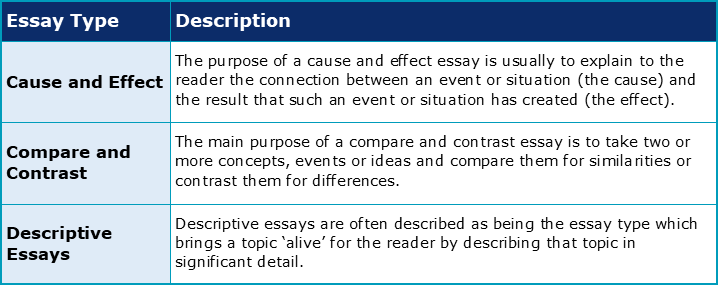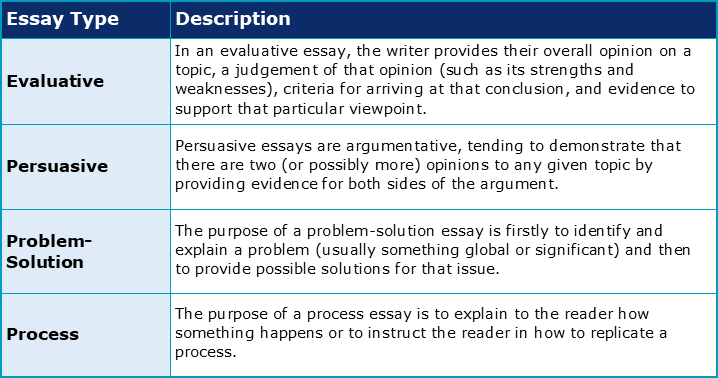What is an academic problem-solution essay?

This is the first of three chapters about Problem-Solution Essays. To complete this reader, read each chapter carefully and then unlock and complete our materials to check your understanding.
– Introduce the concept of essay types in academic English
– Discuss the seven most common essay types
– Provide specific features and numerous example questions for problem-solution essays.
Before you begin reading...
-
video and audio texts
-
knowledge checks and quizzes
-
skills practices, tasks and assignments
Chapter 1
While it might be true that writing an effective academic essay is one of the most challenging skills to master, provided students and researchers at first follow tried and tested methods for how to plan, organise and compose their essay then success should certainly be achievable. While there are a multitude of different essay types with varying structures and emphasis, this short reader focuses specifically on writing problem-solution essays. In Chapter 1, we explore the unique aspects of the problem-solution essay before moving on in Chapter 2 to the six steps for clarity and success. Finally, Chapter 3 provides students and teachers with a five-paragraph example essay to be used as a model for both structure and language.
What are the seven essay types?
Before exploring the problem-solution essay in significant detail, it’s important that we first briefly introduce the various types of essay available to researchers and academics. It’s vital that students can identify each of the following seven essay types as each may require unique language structures and organisation. Each of these seven types may also necessitate different levels of research and varying strengths of argumentation:



What are the features of a problem-solution essay?
Problem-solution essays are relatively common and may be encountered as assignments in the preliminary year or as components of English proficiency tests such as IELTS and TOEFL. An essay of this type usually provides the reader with a situation such as ‘air quality in developing countries’ and then asks the writer to focus on three aspects:(1) identify the problems the situation has caused, (2) outline possible solutions to those problems, and (3) evaluate the efficacy of those solutions.
While problems and solutions are of course necessary in a problem-solution essay, the evaluations of these solutions (their strengths and weaknesses) are somewhat essay dependent. If included at all, such evaluations might be placed within the body section directly after each solution or they might be saved for the end of the essay – such as in the conclusion. While there may be a number of structures possible when writing a problem-solution essay, what is generally common in all such essays is that the writer is able to do the following:
- engage the reader with the problems raised
- convince the reader of the significance of those problems
- clearly and effectively explain the solutions offered
- convince the reader of the efficacy of those solutions
What this means is that any problems a writer includes will need to be explained and their importance highlighted to the reader. As for the solutions, these will also need to be discussed clearly and concisely – with comprehensive considerations provided. How will a solution resolve an issue, for example, or who will enact and fund the solution, and is that solution feasible and cost effective? To convince your reader of your solutions, a writer will of course be required to conduct sufficient research to provide sources that support their claims, arguments and evaluations.
What are some example problem-solution questions?
Because not all problem-solution essay questions include the words ‘problem’ or ‘solution’, we’ve provided twelve example questions below so that students can become more comfortable and familiar with knowing when a problem-solution essay is and isn’t required:

In which ways can poverty be quickly solved?
How can students best deal with noisy roommates?
What are the key ways of reducing childhood obesity?
What is the best way to help someone who is anxious?
Is there any solution to the North Korea nuclear crisis?
How can education be made more affordable for students?
How can governments better reduce the number of smokers?
What are some of the best methods to deal with addiction?
What are some policies for improving the US-China trade war?
How can we encourage the general public to be less prejudiced?
How has digital communication affected face-to-face relationships?
Which policies would best alleviate the problem of illegal immigration?
Now that we’ve explored the basic concepts of problem-solution essays, students shouldn’t forget to check their comprehension by unlocking Chapter 1’s activities. Following this, Chapter 2 next focuses on the six most important steps for creating effective problem-solution essays.
To reference this reader:
Academic Marker (2022) Problem-Solution Essays. Available at: https://academicmarker.com/essay-writing/essay-types/problem-solution-essays/ (Accessed: Date Month Year).
Downloadables
Once you’ve completed all three chapters in this short reader about Problem-Solution Essays, you might then wish to download our Chapter Worksheets to check your progress or print for your students. These professional PDF worksheets can be easily accessed for only a few Academic Marks.
Chapter 1 explores the topic: What is an academic problem-solution essay? Our Chapter 1 Worksheet (containing guidance, activities and answer keys) can be accessed here at the click of a button.
Chapter 2 explores the topic: What makes a problem-solution essay successful? Our Chapter 2 Worksheet (containing guidance, activities and answer keys) can be accessed here at the click of a button.
Chapter 3 explores the topic: What is an example problem-solution essay? Our Chapter 3 Worksheet (containing guidance, activities and answer keys) can be accessed here at the click of a button.
To save yourself 2 Marks, click on the button below to gain unlimited access to all of our Problem-Solution Essays Chapter Worksheets. This All-in-1 Pack includes every chapter, activity and answer key related this topic in one handy and professional PDF.
Collect Academic Marks
-
100 Marks for joining
-
25 Marks for daily e-learning
-
100-200 for feedback/testimonials
-
100-500 for referring your colleages/friends